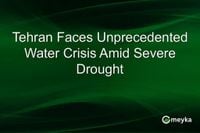Tehran, the bustling heart of Iran, is facing a crisis that has left millions of residents on edge and officials scrambling for solutions. As of early November 2025, the city is grappling with an unprecedented water emergency, the likes of which have not been seen in decades. The reservoirs that supply the capital have plummeted to historic lows, threatening both the drinking water supply and the city’s ability to generate electricity, according to ABC.
This crisis did not appear overnight. Over the past year, Iran has suffered a dramatic 50% drop in rainfall, as reported by Iran International. The country is currently experiencing one of its worst droughts in decades, and the consequences are being felt most acutely in urban centers like Tehran, where the demand for water is relentless due to the city’s dense population. With the reservoirs running dry, officials have been forced to consider—and, in some neighborhoods, quietly implement—water rationing measures that disrupt both residential and industrial life.
According to reports from Iranian media cited by Haft-e Sobh and Mizan News Agency, water rationing has already begun in several Tehran neighborhoods. Residents have faced nightly supply cuts from midnight until around 5 a.m., often without any official announcement or public warning. One resident told Haft-e Sobh, “When the water is cut off at night, we don’t know when it will return, so we can’t plan our use. Even tanks empty quickly.” These sudden shutdowns have upended daily routines, making it nearly impossible for families to manage basic hygiene and household chores.
The situation is so dire that President Masoud Pezeshkian issued a stark warning on November 6, 2025: if rain does not arrive by December, water rationing will be necessary across all of Tehran, and if the drought continues, the city could even face evacuations. This isn’t just a hypothetical threat. The head of Tehran’s provincial water company described the situation as “red and concerning,” underscoring the gravity of the crisis.
Tehran’s water supply depends heavily on the Karaj Dam, which, as of early November, has enough reserves for only two weeks of drinking water. This razor-thin margin has left both officials and residents anxiously watching the skies, hoping for rain that meteorological data suggests is unlikely to arrive anytime soon. Mohammadreza Kavianpour, head of Iran’s Water Research Institute, noted that 20 provinces have gone more than six weeks without measurable rainfall, and forecasts indicate the drought will persist through the season. “The risk of water scarcity in the capital must be taken very seriously,” Kavianpour warned, as quoted by Haft-e Sobh.
The impacts of this crisis extend far beyond empty taps and dry reservoirs. The drought has devastated Iran’s agriculture, the backbone of the economy, leading to lower crop yields and a sharp rise in food prices. This, in turn, has exacerbated existing economic challenges and fueled public discontent. Environmental consequences are equally alarming, with depleted water bodies threatening biodiversity and increasing the risk of desertification—a process that could have irreversible effects on the region’s ecological balance, as highlighted by Meyka AI PTY LTD.
Unannounced water rationing has also raised serious health and cost concerns. According to Haft-e Sobh, unreliable water supply may increase health risks in residential buildings, particularly those dependent on steady water access for sanitation. Families are now forced to rely on water tanks or delivery services, which imposes additional financial burdens at a time when many are already struggling with rising food prices and economic instability.
Experts and environmental advocates argue that the roots of Iran’s water crisis run deep. Years of over-extraction, unscientific dam-building, and poor management have pushed the country toward what some describe as “water bankruptcy.” As surface and groundwater reserves dwindle, the instability of Tehran’s water network becomes more pronounced, threatening not just the capital but the entire nation’s public welfare and long-term sustainability.
The government faces mounting pressure to act. While water rationing may offer temporary relief, it is not a sustainable solution. Legal and governmental systems are being called upon to devise and implement effective water policies that prioritize conservation and equitable distribution. Regulatory changes are under consideration, with a focus on balancing the needs of urban and rural communities—a challenge that requires transparency and fairness to maintain public trust, according to Iran International.
Long-term solutions are being discussed, including investments in desalination, wastewater treatment, improved infrastructure, and innovative conservation technologies. Policymakers and experts agree that addressing the crisis head-on is essential not only for Tehran’s inhabitants but for the stability and growth of Iran as a whole. Public awareness campaigns and conservation initiatives are also seen as crucial steps in building resilience against future droughts and water shortages.
As the crisis unfolds, the resilience of Tehran’s residents is being tested daily. Many have adapted to the nightly water cuts by storing water in tanks or adjusting their routines, but frustration is mounting. The unpredictability of the supply has left people feeling vulnerable and anxious about the future. “Despite repeated denials by officials, it appears the process of rationing has started,” wrote Mizan News Agency, capturing the growing sense of unease among citizens deprived of water during the night.
The broader implications of Tehran’s water crisis cannot be ignored. It is a stark reminder of the vulnerabilities within Iran’s water management systems and the urgent need for comprehensive, forward-thinking strategies. The situation in Tehran is not unique; cities across the Middle East and beyond are grappling with similar challenges as climate change intensifies droughts and strains aging infrastructure.
For now, all eyes are on the weather—and on the government’s ability to steer the city through this perilous moment. The coming weeks will be critical. If rain does not come, Tehran could face even harsher rationing, or, in the worst-case scenario, the evacuation of parts of the city. The choices made now will shape the city’s future and serve as a cautionary tale for other urban centers facing the growing threat of water scarcity.
Tehran’s struggle with water scarcity is a wake-up call, not just for Iran but for any city vulnerable to the whims of nature and the consequences of human mismanagement. The path forward will require both immediate action and a long-term vision—one that recognizes water as the lifeblood of a nation and the foundation of its people’s well-being.





